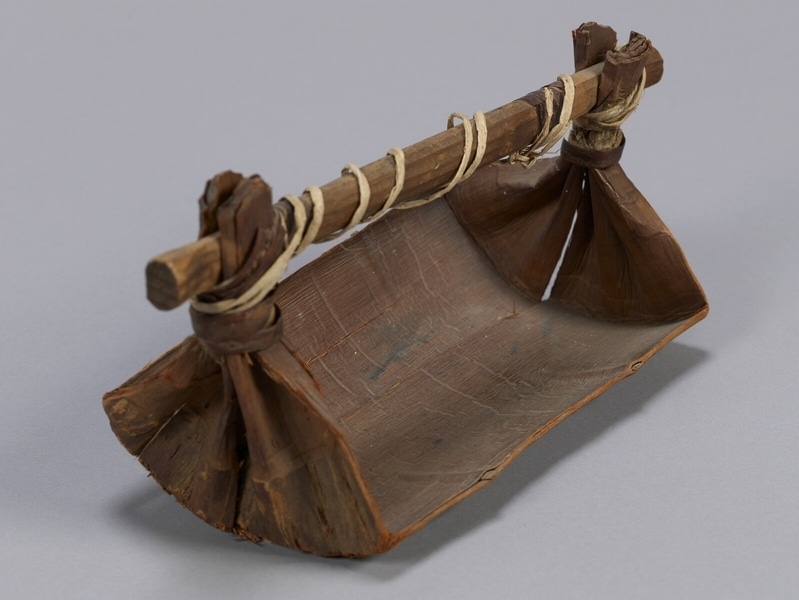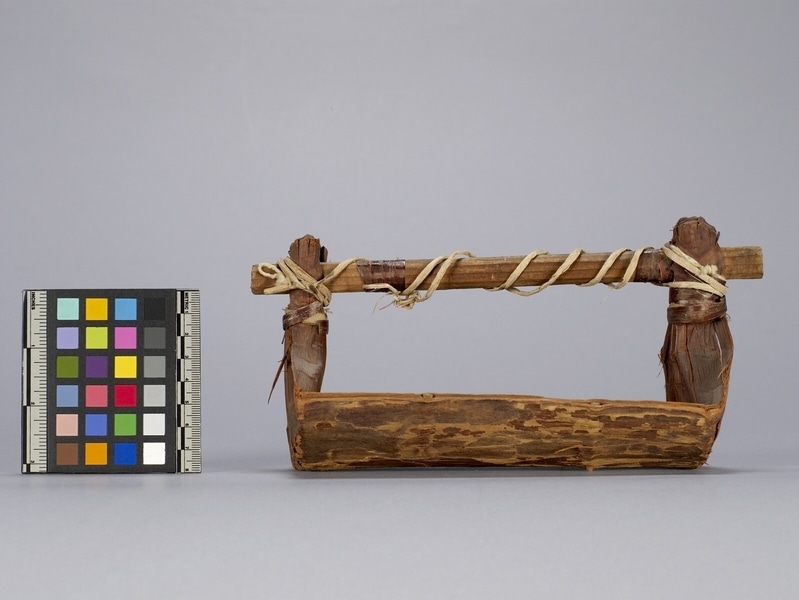Canoe Bailer Item Number: Nb580 from the MOA: University of British Columbia


Description
Small canoe bailer made of cedar bark with wooden handle. Outer bark on exterior surface, but removed from ends which are pleated and tied to the wooden handle. The ends are secured with white cotton string which has been covered over with red cherry bark. An off-white coloured plant material, possibly yellow cedar bark, has been wrapped loosely around the length of the handle in the manner of a decoration. Small wooden splints have been inserted between the inner and outer bark, two on each side, to keep the edges straight.
History Of Use
Canoe bailers are used to remove excess water out of the bottom of canoes. Barnett notes: "The implement was effective as a scoop rather than as a dipper, and as such could be manipulated rapidly. The Cowichans and Nanaimo added a large wooden ladle for bailing (1955:116)."
Cultural Context
water travel
Specific Techniques
Canoe bailers are made from rectangular pieces of cedar bark. The bark is harvested from living trees in the spring when the sap is running, usually between May and June. A prayer, and sometimes an offering, is made to the tree for the gift of its skin. An incision is made with an axe, or other bladed implement, and the bark is peeled off by pulling from side to side. It is better to peel the tree this way, because it will result in a wider piece. If you pull straight back from the tree the bark will quickly narrow to a thin strip. Only the width of two hands is taken so that no harm will be done to the tree. The canoe bailer is made from a short rectangular piece, and the outer bark is removed from the end portions. The pliable ends are pleated and secured to a handle with strips of cedar bark or some other type of twine.
Item History
- Made in Vancouver Island, British Columbia, Canada ? between 1870 and 1880
- Collected in Vancouver Island, British Columbia, Canada
- Owned by Rout A. Harvey before March 14, 1977
- Received from Rout A. Harvey (Donor) on March 14, 1977
What
- Name
- Canoe Bailer
- Identification Number
- Nb580
- Type of Item
- bailer
- Material
- cedar bark, wood, cotton fibre, bark ? and cherry bark
- Manufacturing Technique
- carved, tied and pleated
- Overall
- height 11.3 cm, width 23.0 cm, depth 10.3 cm
Who
- Culture
- Coast Salish
- Previous Owner
- Rout A. Harvey
- Received from
- Rout A. Harvey (Donor)
Where
- Holding Institution
- MOA: University of British Columbia
- Made in
- Vancouver Island, British Columbia, Canada ?
- Collected in
- Vancouver Island, British Columbia, Canada
When
- Creation Date
- between 1870 and 1880
- Ownership Date
- before March 14, 1977
- Acquisition Date
- on March 14, 1977
Other
- Condition
- fair
- Current Location
- Case 7
- Accession Number
- 0368/0002